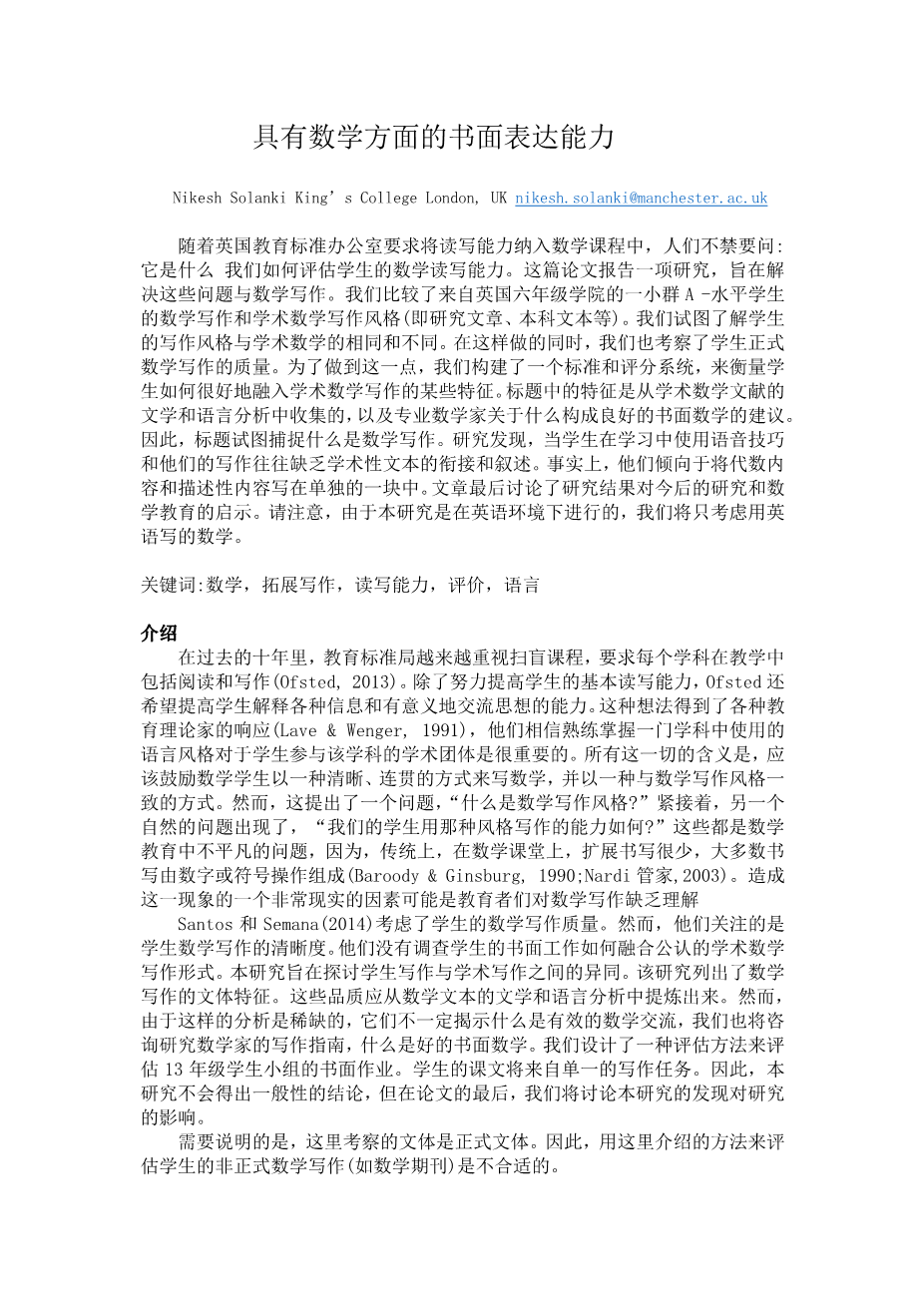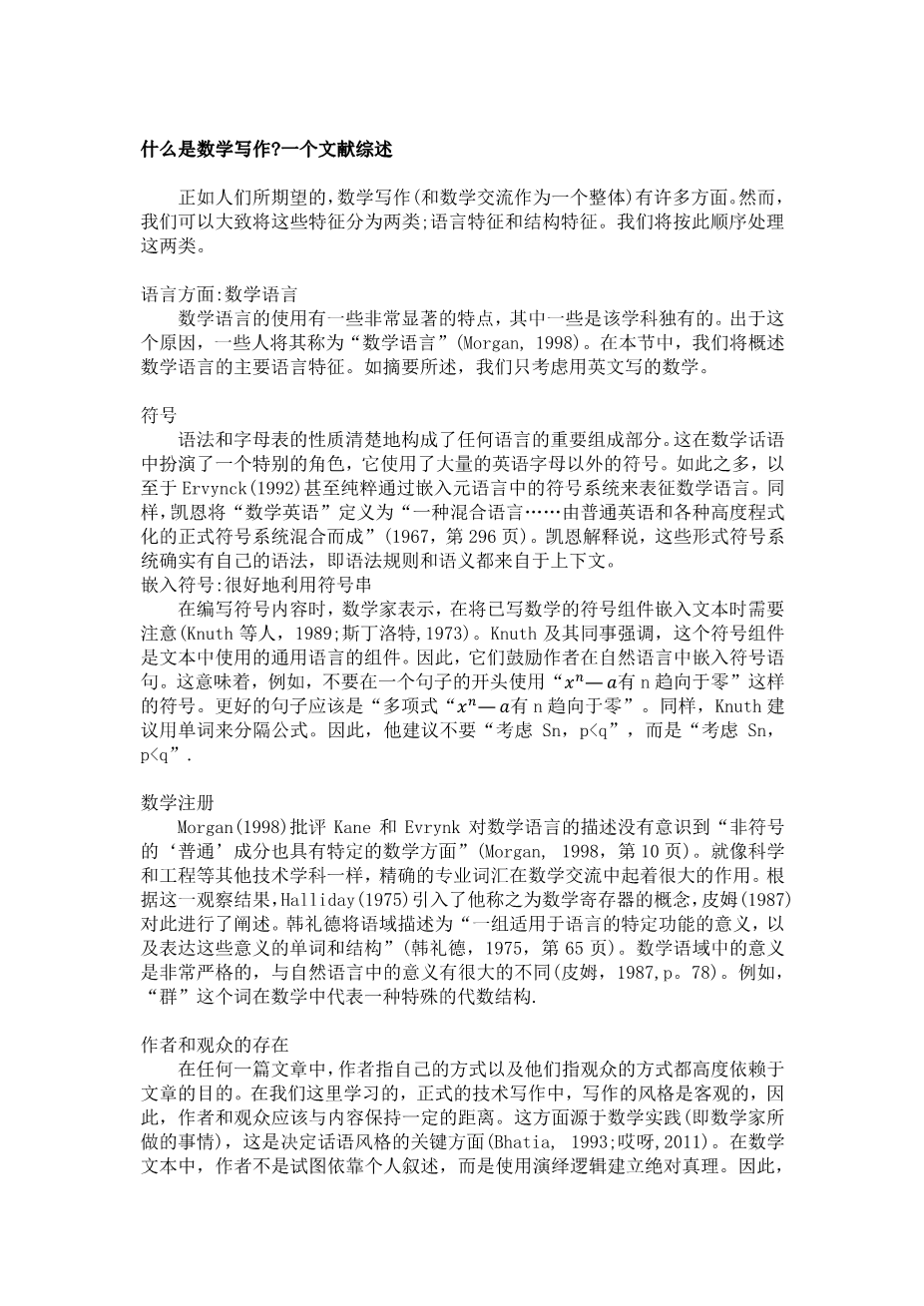具有数学方面的书面表达能力外文翻译资料
2022-08-27 09:58:44
Cambridge Open-Review Educational Research e-Journal Vol. 5, November 2018, pp. 4-27
Assessing Formal Written Ability in Mathematics
Nikesh Solanki
Kingrsquo;s College London, UK nikesh.solanki@manchester.ac.uk
With demands to include literacy in mathematics lessons from Ofsted it becomes desirable to ask what mathematical literacy is and how can we assess whether students are mathematically literate. This paper reports on a study which is aimed at addressing these questions with regards to mathematical writing. We compare the mathematical writing of small group of A-Level students from a British sixth form college to the writing style of academic mathematics (i.e. research articles, undergraduate texts etc.). We seek to understand the similarities and differences of the studentsrsquo; writing style to that of academic mathematics. In doing so we also look at the quality of studentsrsquo; formal mathematical writing. To do this we construct a rubric and grading system which measures how well students incorporate certain characteristics of academic mathematical writing. The characteristics in the rubric are gleaned from literary and linguistic analysis of academic mathematics literature as well as advice from professional mathematicians as to what constitutes good written mathematics. As such, the rubric tries to capture what mathematical writing is. It is found that while the students in the study use voicing techniques and formality expected in academic mathematics, their writing tends to lack cohesion and narrative of academic text. Indeed, they tend to write algebraic content and descriptive content in separate blocks. At the end of the paper we discuss the implications of the findings for further research and mathematics education. Note that since this research is set in an English-speaking context, we shall only consider mathematics written in English.
Keywords: mathematics, extended writing, literacy, assessment, linguistics
Introduction
Over the past decade there has been an increased focus on literacy across the curriculum with
Ofsted requiring each subject to include reading and writing within their teaching (Ofsted, 2013). As well as attempting to boost basic literacy, Ofsted are hoping to improve studentsrsquo; ability to interpret various different kinds of information and communicate their thoughts meaningfully. This thought is echoed by various educational theorists (Lave amp; Wenger, 1991) who believe proficiency with the style of language used in a subject is important for the studentsrsquo; participation with the academic community of that subject. The implication of all this is that a mathematics student should be encouraged to write mathematics in a way that is clear, coherent and in a way that is consistent with the style of writing in mathematics. However this raises the question, “what is the mathematical style of writing?” Following this, another natural question arises, “how capable our pupils of writing in that style?” These are non-trivial questions in mathematics education since, traditionally, extended writing has been sparse in mathematics classrooms, with most writing consisting of number of or symbolic manipulations (Baroody amp; Ginsburg, 1990; Nardi amp; Steward, 2003). A very real factor for this may be a lack of understanding among educators of what mathematical writing is.
The quality of studentsrsquo; mathematical writing has been considered by Santos and Semana
(2014). However, their focus was on the clarity of studentsrsquo; mathematical writing. They do not investigate how well studentsrsquo; written work converges accepted form of academic mathematical writing. The present work is dedicated investigating the similarities and differences between studentsrsquo; writing and that of academics. The study provides a rubric consisting the stylistic features found in mathematical writing. These qualities shall be distilled from literary and linguistic analyses of mathematical texts. However, since such analyses are scarce and they do not necessarily reveal what effective mathematical communication is, we shall also consult writing guides from research mathematicians on what makes good written mathematics. An assessment method is designed to go with this rubric which we shall use to assess the written work of small group of year 13 students. The studentsrsquo; texts will be from single writing task. Hence, no general conclusions will be drawn from this study but at the end of the paper we shall discuss the implications of the findings of this study for research. It should be clarified the style of writing being investigated here is formal in style. Hence, it would not be appropriate to assess studentsrsquo; informal mathematical writing (such as maths journals) using the techniques presented here.
What is mathematical writing? A literature review
As one would expect, mathematical writing (and mathematical communication as a whole) has many facets to it. However, we can roughly categorise these characteristics into two groups; linguistic characteristics and structural ones. We shall address these two categories in that order.
Linguistic aspects: The mathematical language
The usage of language in mathematics has some very pronounced characteristics, some of which are unique to the subject. For this reason, some have dubbed it the lsquo;language of mathematicsrsquo; (Morgan, 1998). We outline the key linguistic characteristics of the language of mathematics in this section. As mentioned in the abstract, we shall only consider mathematics written in English.
Symbols
Syntax and the nature of the alphabet used clearly form an important part of any language. This takes on a particularly speci
剩余内容已隐藏,支付完成后下载完整资料


英语译文共 5 页,剩余内容已隐藏,支付完成后下载完整资料
资料编号:[405952],资料为PDF文档或Word文档,PDF文档可免费转换为Word




